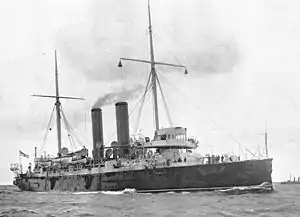HMS St George (1892)
HMS St George was a first class cruiser of the Edgar class. She was launched on 23 June 1892.
 | |
| History | |
|---|---|
| Name: | HMS St George |
| Builder: | C & W Earle, Hull |
| Laid down: | 23 April 1890 |
| Launched: | 23 June 1892 |
| Reclassified: | Depot ship 1909 |
| Fate: | Sold for breaking up 1 July 1920 |
| General characteristics | |
| Class and type: | Edgar-class cruiser |
| Displacement: | 7,350 tons |
| Length: | 387.5 ft (118.1 m) |
| Beam: | 60 ft (18 m) |
| Armament: |
|
Service history
St George took part in the 40-minute-long Anglo-Zanzibar War in 1896. The obsolete armed yacht HHS Glasgow of Zanzibar fired upon a British flotilla led by St George, also comprising Philomel, Racoon, Sparrow and Thrush. The response sank Glasgow with a hole below the waterline. With a Union Jack flying over the sinking yacht in surrender, the flotilla launched lifeboats to rescue the crew of Glasgow which would lie at the bottom of Zanzibar Town Harbour until 1912.
She served in the Channel Fleet. In 1901, she was one of two escort ships for the royal yacht Ophir, which carried the Duke and Duchess of Cornwall and York (later King George V and Queen Mary) during their tour of the British Empire.
Following the end of this tour, the captain of Ophir, Commodore Alfred Winsloe, reverted to his position as Commodore commanding the Cruiser squadron, and was in late 1901 posted to St George,[1] which thus became the lead ship of the squadron and carried his broad pennant. In May 1902 she was taken into Portsmouth for a refit.[2] She took part in the fleet review at Spithead on 16 August 1902 for the coronation of King Edward VII,[3] and in September that year was part of a squadron visiting Nauplia and Crete for combined manoeuvres in the Mediterranean Sea.[4] After her return to Portsmouth in late October, she paid off on 15 November and her crew was transferred to HMS Good Hope.[5]
She was the flagship of the Cape & West Africa Station (Rear-Admiral Harry Rawson) based at Simon's Town, and served in the First World War.
She was designated as a depot ship in 1909, and sold for breaking up at Plymouth on 1 July 1920.
List of Captains
- Captain Paul W. Bush, 26 February 1901 - ?[6]
- Captain Sidney R. Olivier, 2 November 1915 – 1919
Notes
- "Naval & Military intelligence". The Times (36607). London. 8 November 1901. p. 6.
- "Naval & Military intelligence". The Times (36756). London. 1 May 1902. p. 6.
- "The Coronation - Naval Review". The Times (36845). London. 13 August 1902. p. 4.
- "Naval & Military intelligence". The Times (36883). London. 26 September 1902. p. 8.
- "Naval & Military intelligence". The Times (36896). London. 11 October 1902. p. 12.
- "Naval and Military intelligence". The Times (36384). London. 21 February 1901. p. 10.
References
- Colledge, J. J.; Warlow, Ben (2006) [1969]. Ships of the Royal Navy: The Complete Record of all Fighting Ships of the Royal Navy (Rev. ed.). London: Chatham Publishing. ISBN 978-1-86176-281-8.
- Roger Chesneau and Eugene M. Kolesnik, ed., Conway's All the World's Fighting Ships, 1860–1905, (Conway Maritime Press, London, 1979), ISBN 0-85177-133-5